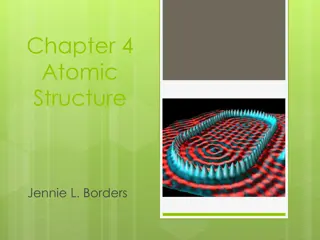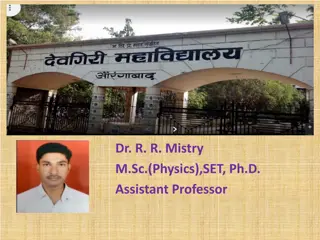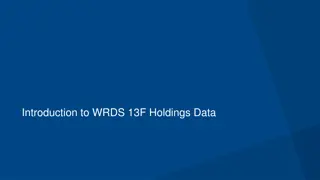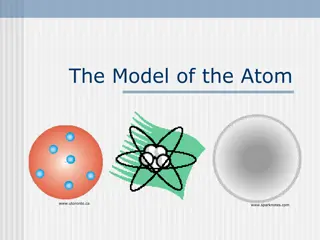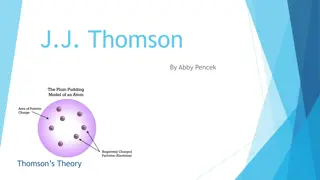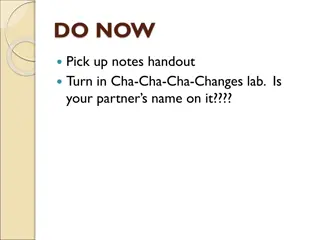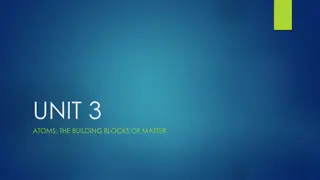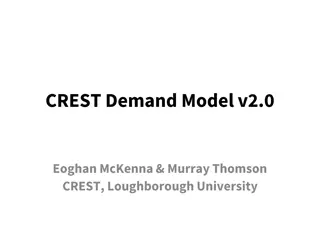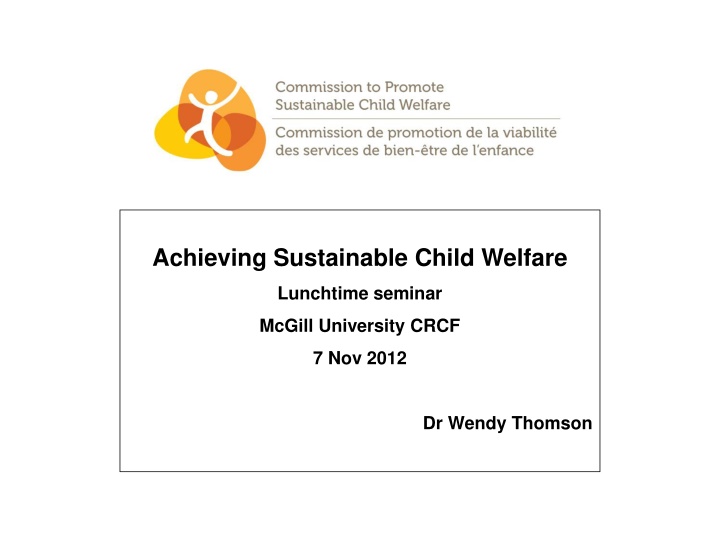
Sustainable Child Welfare: Strategies for a Better Future
Explore the initiatives and strategies outlined in a seminar at McGill University for achieving sustainable child welfare. Highlights include the need for system adaptation, resource optimization, and accountability systems. Early conclusions suggest reconfiguration of child welfare organizations and a new funding approach for long-term sustainability.
Download Presentation

Please find below an Image/Link to download the presentation.
The content on the website is provided AS IS for your information and personal use only. It may not be sold, licensed, or shared on other websites without obtaining consent from the author. If you encounter any issues during the download, it is possible that the publisher has removed the file from their server.
You are allowed to download the files provided on this website for personal or commercial use, subject to the condition that they are used lawfully. All files are the property of their respective owners.
The content on the website is provided AS IS for your information and personal use only. It may not be sold, licensed, or shared on other websites without obtaining consent from the author.
E N D
Presentation Transcript
Achieving Sustainable Child Welfare Lunchtime seminar McGill University CRCF 7 Nov 2012 Dr Wendy Thomson
Context 1. Recap of Our Starting Point and the Resulting Vision and Strategy for Sustainability 2. Highlights of our Strategy The change we are driving Progress and Results 3. Final Report 2
Starting Point Commission Terms of Reference Commission Terms of Reference The mandate of the Commission is to develop and implement initiatives that will contribute to moving the children s aid societies and ministry towards sustainability and the reinvestment in better outcomes for children and youth in need of protection. Commission Definition of A Sustainable Child Welfare System .. Constantly adapts to evolving challenges, needs and knowledge Leverages available resources to maximize positive outcomes for children and youth Balances current needs and demands while building a strong system for tomorrow 3
The Systems Approach to Sustainable Child Welfare Governance Should child welfare services continue to be delivered through independent organizations, each with their own board? Policy Character Is the Transformation agenda the right approach? Program & Service Configuration Should there be changes to the way programs are defined and services structured and delivered? Is 53 the right number of CAS? Funding Approach What approach to funding services will encourage equity between agencies and value for children and communities? Systems of Accountability What systems of accountability will best deliver results, for children as well as government ministers? How do we ensure that we know how the system is performing and what kind of outcomes it is producing? Culture Culture Is there consistency in cultural orientation between the sector and government? Does the culture promote sustainability? 4
The Commissions Early Conclusions CAS spending is not out of control Transformation is working, but obstacles to be removed to move forward Opportunities for improvement within the sector, MCYS, and between sectors Sustainability will require: CAS reconfiguration to achieve scale and capacity A new approach to funding A new approach to accountability with clearer CAS and MCYS roles A fundamental change in approach to Aboriginal child welfare Attention to direct services, particularly: strengthening families, securing permanence; shortening time in out-of-home care; and administrative burden 5
Fifteen Year Trends in Child Welfare Spending % annual increase (based on nominal dollars) 35% Uploading from municipalities takes effect over these two years. Province assumes remaining 20% of cost of child welfare 30% 25% 20% Recession, Rae Days, Common Sense Revolution 15% 10% 5% 0% 1994/95 1995/06 1996/97 1997/98 1998/99 1999/00 2000/01 2001/02 2002/03 2003/04 2004/05 2005/06 2006/07 2007/08 2008/09 2009/10 -5% Multiple Policy Reviews Child Mortality Task Force (1997) Expert panel on child protection (1998) Eight inquests into deaths of children known to CASs Multiple Policy changes 2000 CFSA Changes: neglect and exposure to domestic violence added as grounds for protection; legal duty to report 2003 Child Welfare Reform 200? Introduction of ORAM (new risk assessment tool) Implementation of the Transformation Agenda 6 Source: Confirm with Ross.
Tier 1: Reconfiguration The Change we advocate .. And Progress Made 13 CASs have amalgamated to create 6 new CAS Realize more comparable and sustainable scale and capacity for CASs through: Have gone from 24 CASs with budgets below $17.9 m to 13 Amalgamations Comprehensive shared services strategy developed: Shared services Cross-sector reconfiguration opportunities OACAS prepared to play a role as coordinating body OntarioBuys engaged in exploring procurement options 8
Tier 1: Reconfiguration Challenges 10 non-Aboriginal CASs still at or below the 25,000 population threshold but most lack a logical local partner Shared services and cross-sector amalgamation will be key. Still issues to address with configuration of Aboriginal CASs multiple options must be addressed as part of broader Aboriginal child welfare strategy Multiple shared service opportunities to realize but will require leadership and political will. 9
Tier 2: Funding The Change we advocate .. and Progress Made Local Needs-Based Funding model recommended Current funding approach impedes sustainability. New approach must: Ensure funding allocation is child- focused, not agency- focused Be more equitable Shift risk from payer (gov t) to provider (CAS) Enable local flexibility Promote CAS resiliency Recommendations tabled for other changes to approach to promote resiliency: Earlier communication of fiscal year funding targets Shifting to multi-year funding and planning Revising rules to allow CASs to retain a portion of in-year surpluses Separate approach for capital budget, planning and approvals Transferring admin responsibility for permanency subsidies to MCYS 10
Child Population Growth versus CAS Expenditure Change, 2003-2009 (Excluding Aboriginal CASs) 140% 120% 100% Expenditure Change 80% 60% 40% 20% 0% -30% -25% -20% -15% -10% Child Population Decreasing -5% 0% 5% 10% 15% 20% Increasing 11
Limitations of the Current Funding Model A Funding Comparison of Two Southern Ontario CASs 2003/04 - 2011/12 Per Capita Comparisons % Change in funding in last 3 years (2008/09 to 2011/12) Per Capita Funding (2011/12) $1,697 $165 Per Capita Children in Care (2009/10) 34.2 3.2 % Change in child population % Change in funding Prince Edward Halton -32% 17% 35% 37% 9% -3% Not child-focused Cost and activity-based shifting risk to the government Not adaptive Has inherent disincentives rewards gaming Creates a reactive, near-term management dynamic that results in instability and lack of resilience in individual CASs Contributes to administrative burden Not aligned with any mechanism for accountability (clarifying expectations and outcomes) 12
Tier 2: Funding Challenges Commitment to new funding approach has been made . But no approach agreed upon as yet. Continued reliance on existing funding approach is rewarding old behaviours (e.g. volume emphasis) Strong attachment to volume connection to funding is creating an impasse? Funding advice for Aboriginal agencies has been provided. Decision / plan required. 2013/14 is coming fast 13
Tier 3: Accountability The Change we advocate .. And Progress made First phase of performance indicators developed and rolled-out. Move from current state of multiple incoherent, disconnected mechanisms to a new framework for accountability providing clearer Purpose & guiding principles Roles & responsibilities Key dimensions of child welfare Three new mechanisms: 1. Multi-year plans 2. Performance indicators 3. Cyclical agency reviews Capacity-building for continuous learning and system improvement OACAS and CAS boards embracing a multi-year process to strengthen governance. Sector taking ownership for their role in leading new approach to accountability. Report and recommendations for implementing accountability framework submitted to the Minister. 14
Tier 3: Accountability Challenges New accountability framework represents major changes for MCYS both cultural and technical .. Leadership and commitment will be essential to introduce: Clear policy objectives and targets, in context of multi-year strategy and accountability agreements Develop and execute agency reviews Introduce and make use of performance metrics. Momentum on performance indicators may be at risk of stalling as Commission hands off. 15
Tier 4: Direct Service The Change we advocate .. And Progress made Report and recommendations complete regarding the Scope of CAS services Complement the influence of the three other tiers in strengthening direct service delivery by focusing on: Addressing barriers to realizing the policy shift intended by the Transformation Agenda Increasing transparency and clarity on the scope (breadth and depth) of services delivered by CASs with child welfare funds. Be a catalyst for sector-led changes in how out- of-home care is delivered by: reducing multiple moves, promoting home-like / family-.like experiences, and enabling youth to grow roots and life-long connections. Reducing the administrative burden, particularly on front-line staff, to increase proportion of time in direct service to children and families. Report and recommendations complete on out-of-home care; sector in process of structuring a project for further action. MYCS has initiated some changes in administrative processes that should have a material impact on the sector in the coming months. 16
Core Concepts in the Commissions Work on Scope The Continuum of Child and Family Needs Family situation results in a child in need of protection as defined by CFSA and requires Children & Families Exiting Child Welfare Services All Vulnerable Children & Families Vulnerable Children & Families All Children & Families Children & Families Community- based child welfare services Out-of- home child welfare services to ensure their safety and well-being Children s Aid Societies Selective Community Services Universal Services Must Provide May Provide CAS Service Categories Should Not Provide 17
Tier 4: Direct Services Challenges Need to move forward purposefully and dispassionately with the Commission s recommendations on Scope particularly the the Transformation policy shift and the service mapping . Engagement of community partners and links to accountability (planning) are critical. Out-of-home care project can and should be sector led but MCYS / gov t has important role in pushing for targets and evidence of results. MCYS will need continued encouragement to stay the course on reducing admin burden and communication / engagement of sector required to ensure benefits realization. CAUTIONS AND ADVICE: A narrow interpretation of the Commission s work on Scope would be regressive. Gov t / MCYS should use the Scope work to reaffirm policy direction and aspiration for shape of child welfare in Ontario and to inform work to further advance broader cross-sector integration 18
Aboriginal Child Welfare The Change we advocate .. And Progress Aboriginal unit established within MCYS to establish the single locus of responsibility as recommended by the Commission. Embrace fundamental changes in the approach to Aboriginal child welfare by taking a broader approach (beyond CAS ) and forging more genuine partnerships with Aboriginal leaders to: Develop an overall strategy for Aboriginal child welfare Take action on near-term priorities to improve efficiency and service delivery Identify and remove barriers to customary care Implement a separate funding approach for Aboriginal CASs (reflecting principles common to non- Aboriginal CASs). Specific shorter-term activities underway/being planned Relationship-building efforts underway at Ministerial and senior executive level 19
Aboriginal Child Welfare Remaining Challenges Progress will always be challenged by tendency to think in government program lines, multiple Aboriginal governments, and the relationship with the federal government. There is, however, both a financial and a moral imperative for Ontario to support Aboriginal communities in regaining the lead role in ensuring the safety and well-being of their children. 20
3/17/2025 21
The Commissions Final Report Submitted to the Minister Commitment to publish 22


